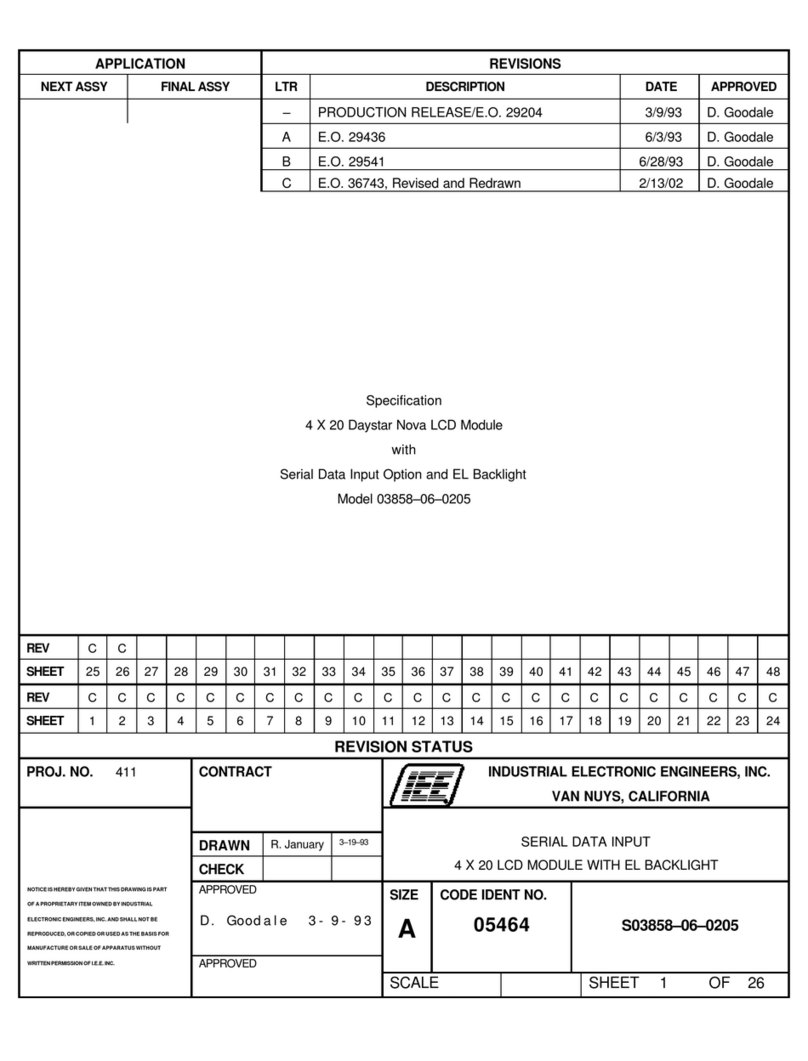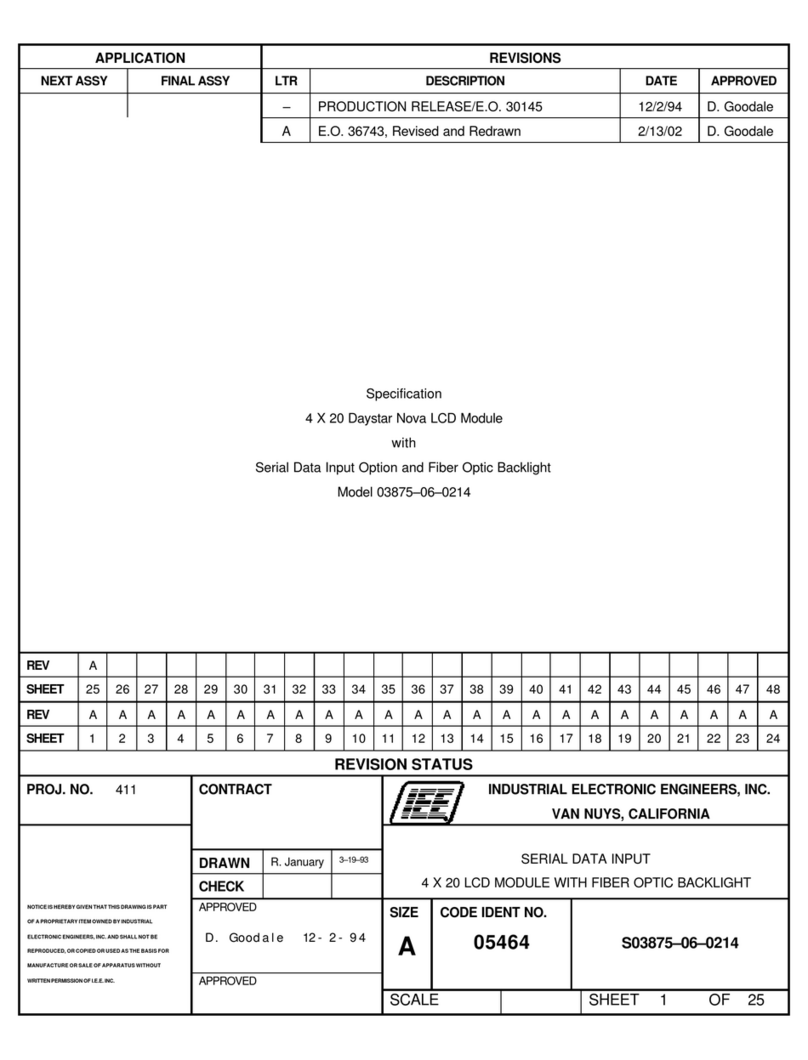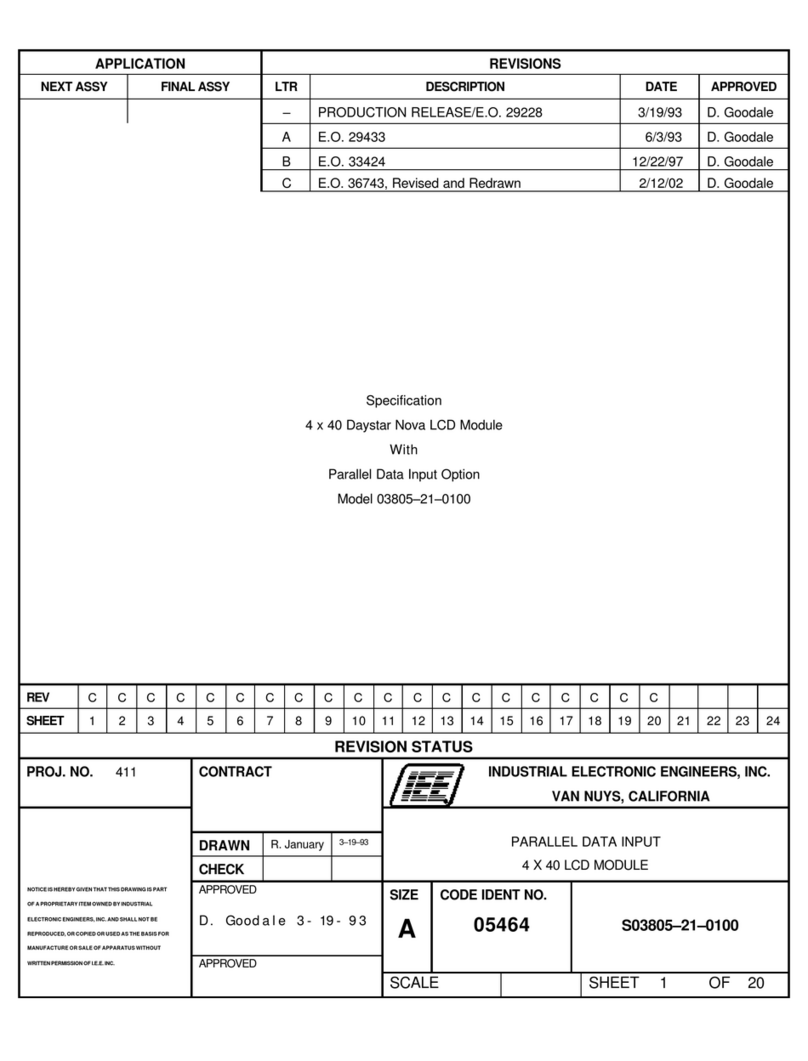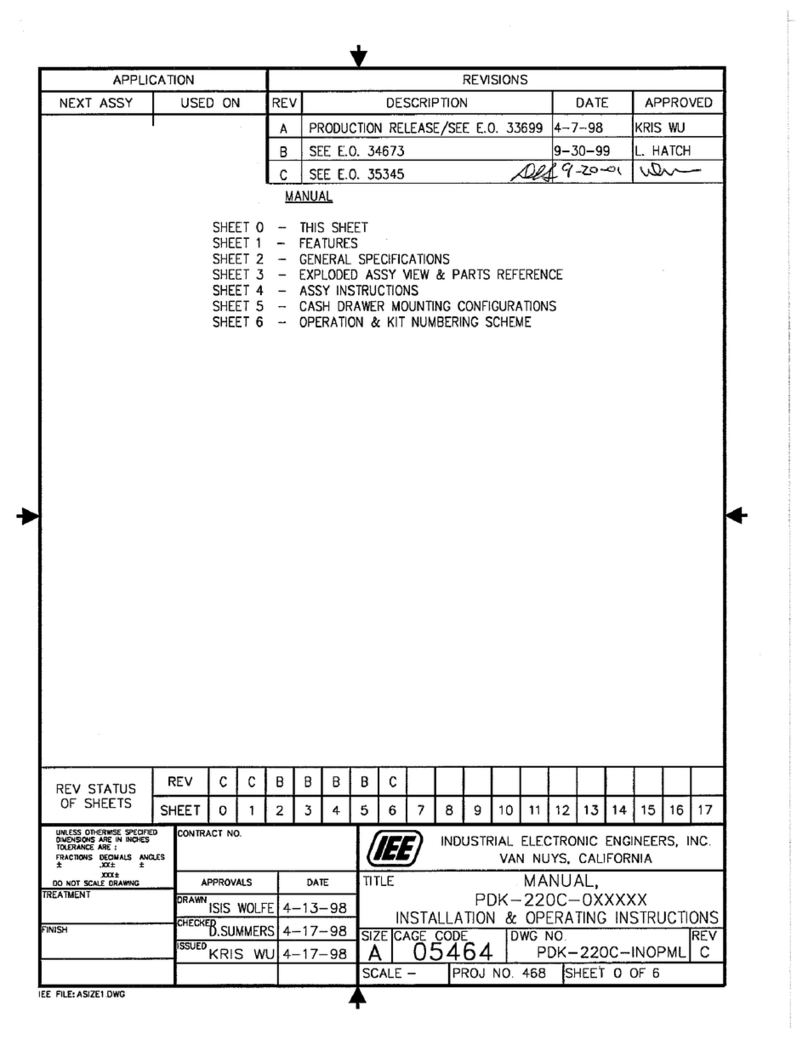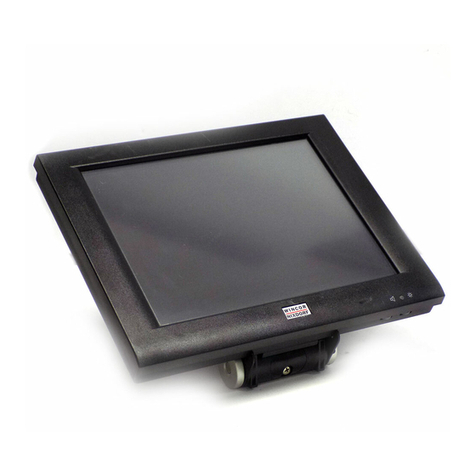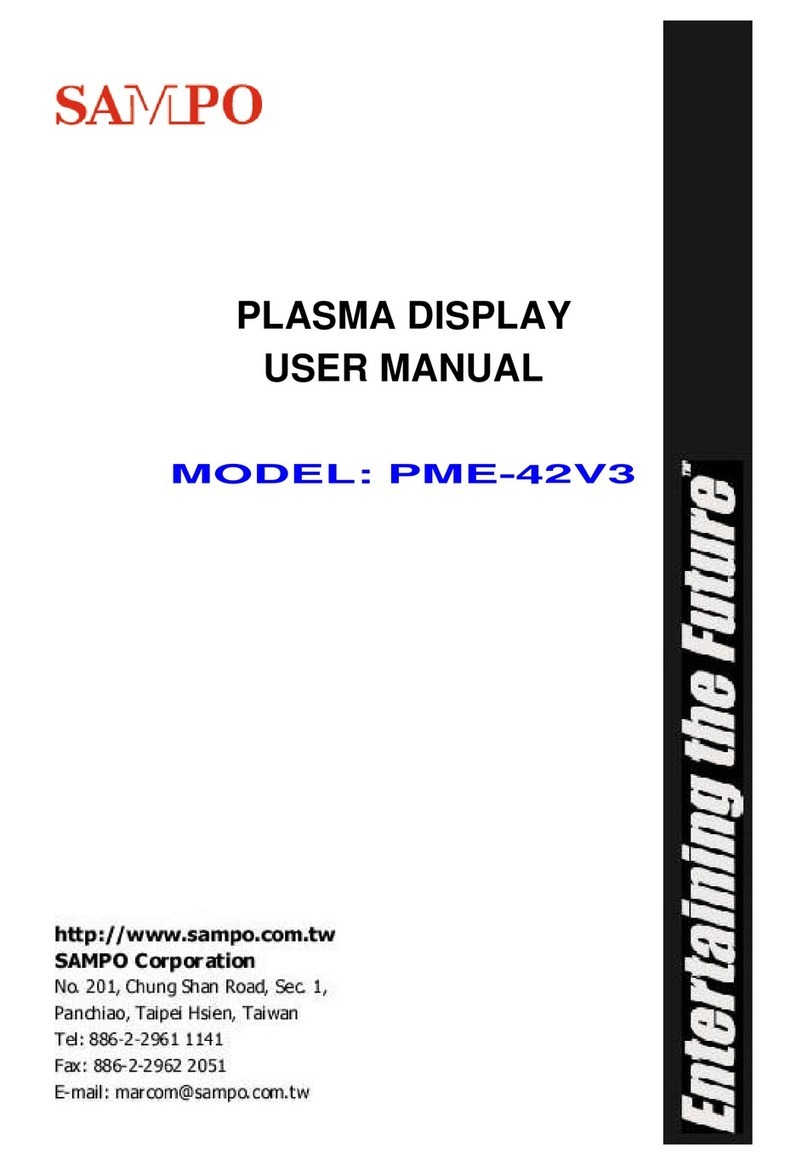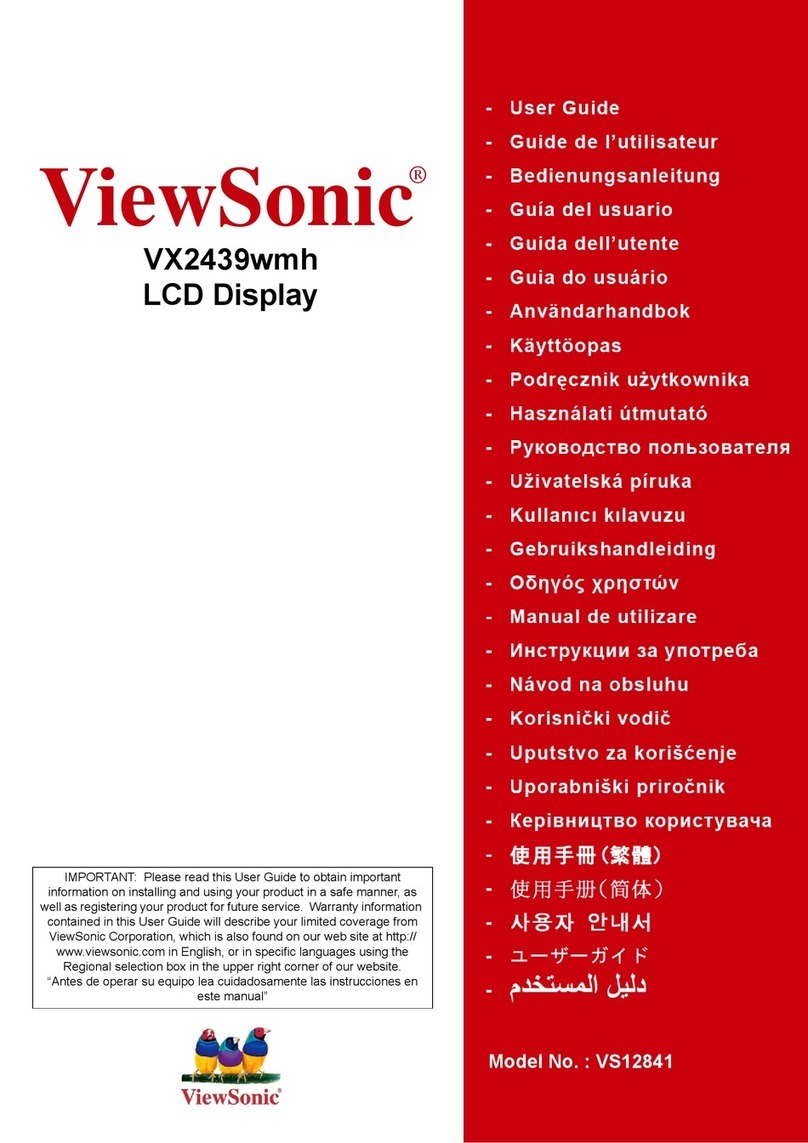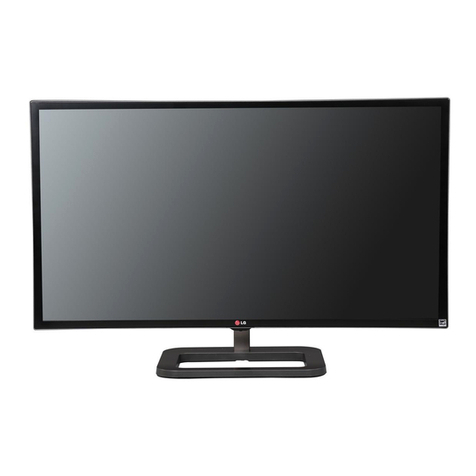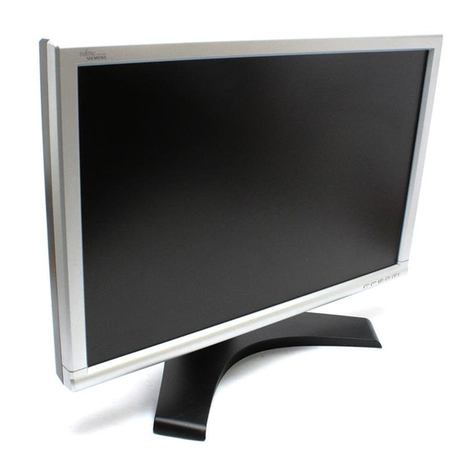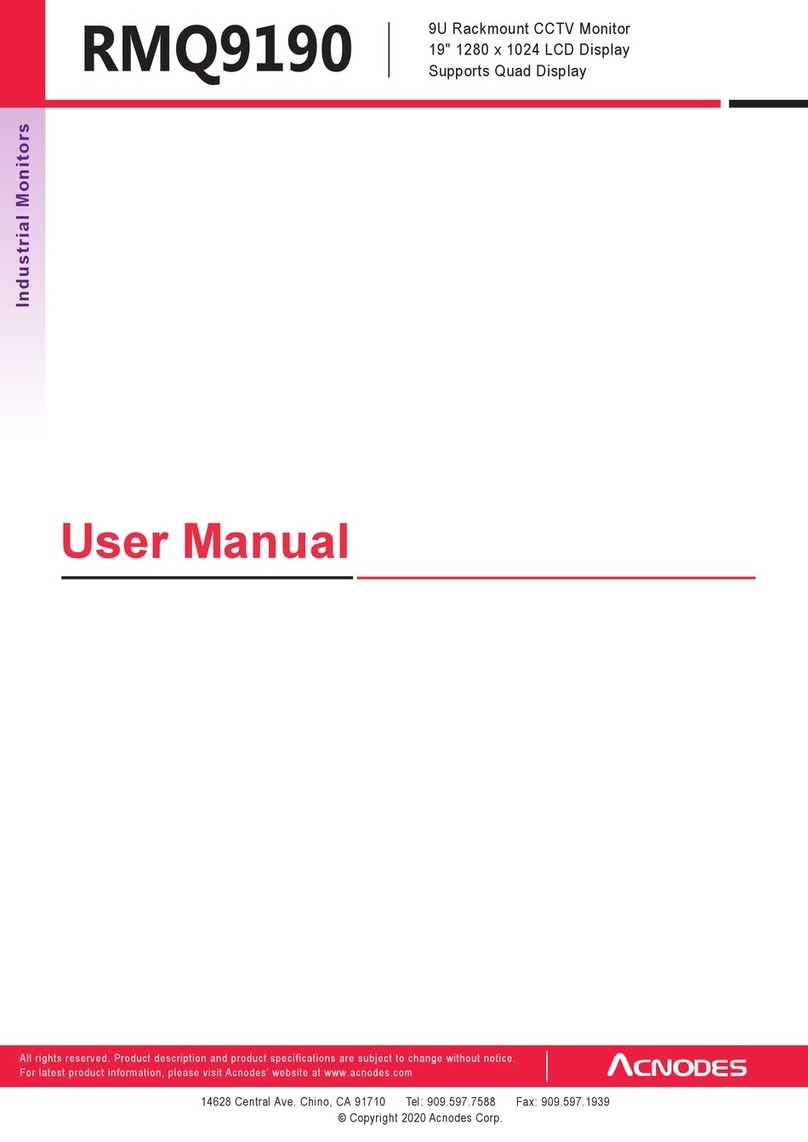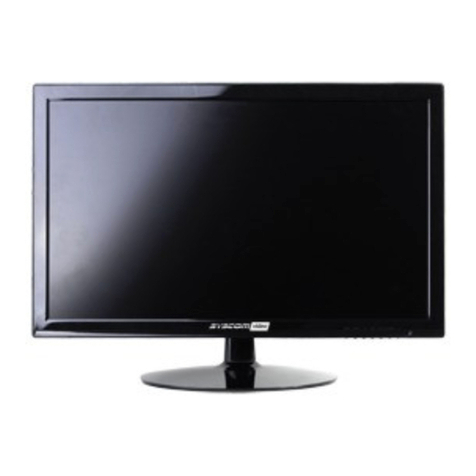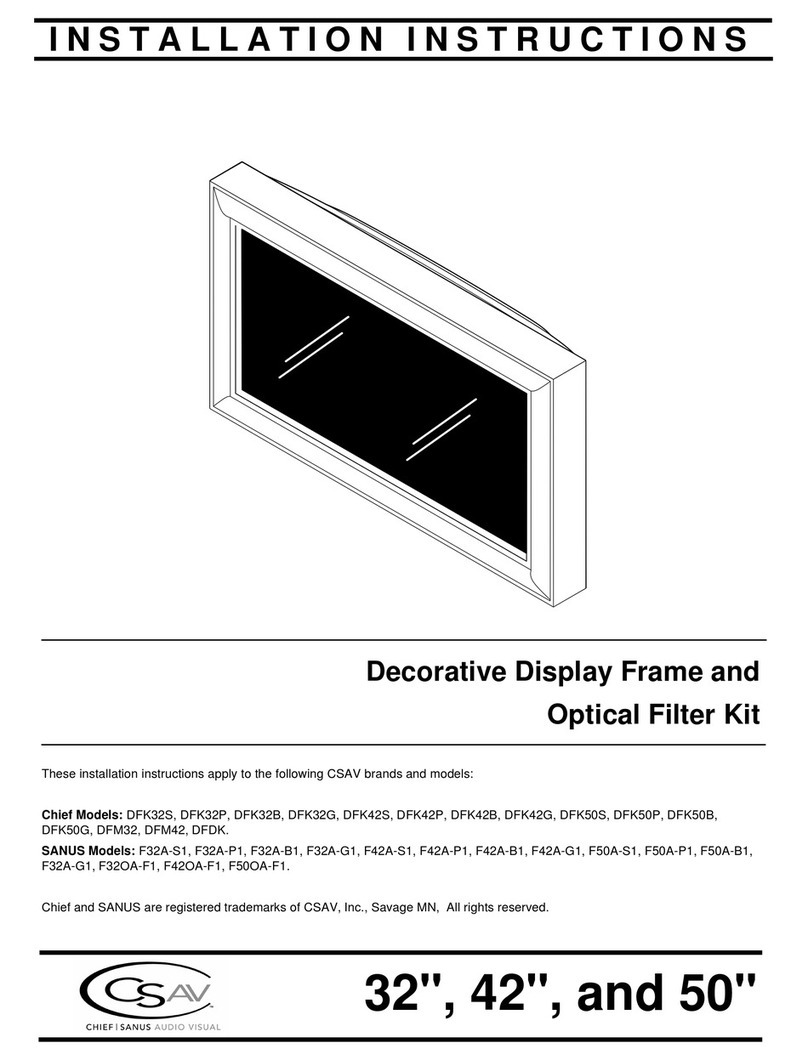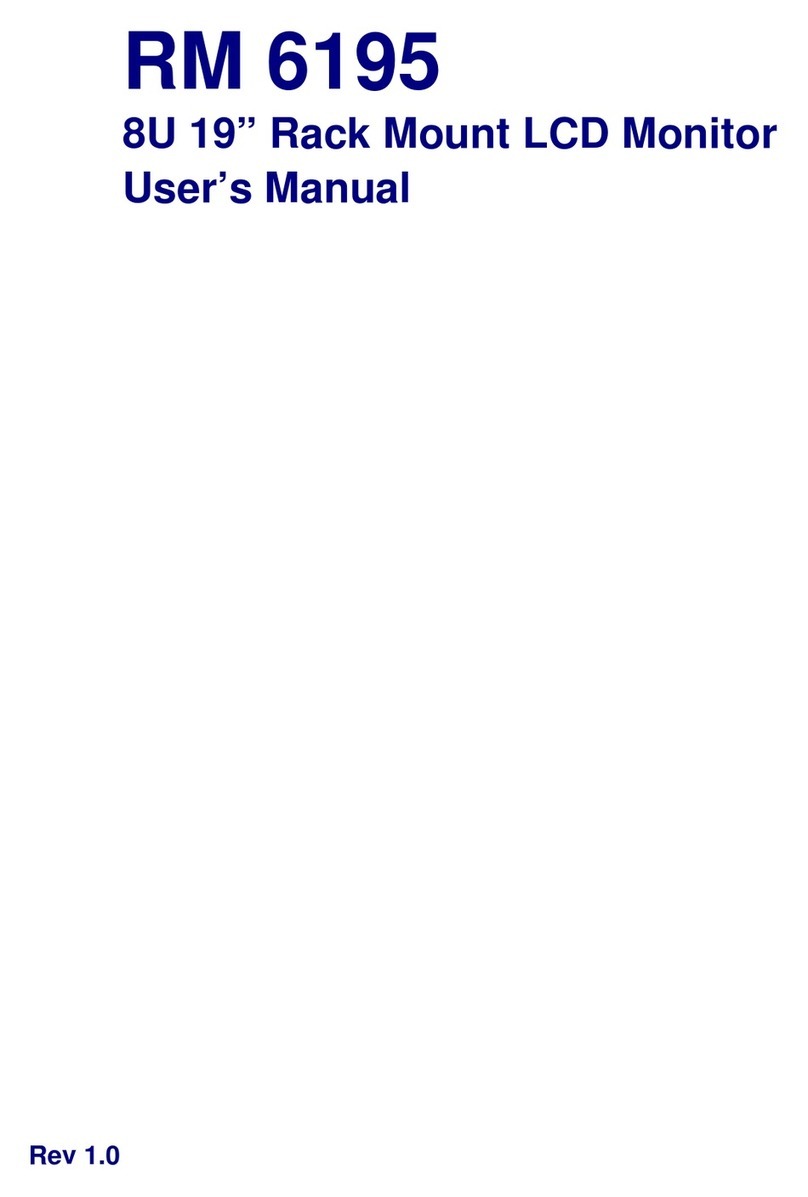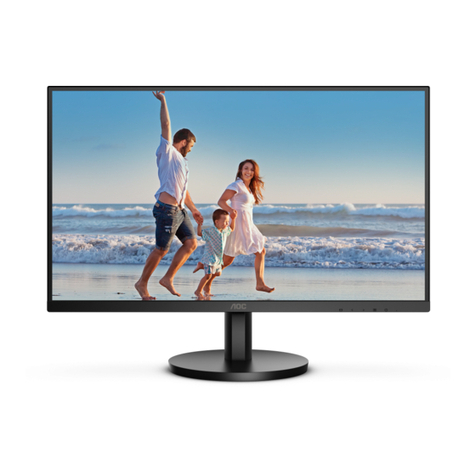IEE 03858-21-0105 User manual

APPLICATION REVISIONS
NEXT ASSY FINAL ASSY LTR DESCRIPTION DATE APPROVED
–PRODUCTION RELEASE/E.O. 29227 3/19/93 D. Goodale
AE.O. 29437 6/3/93 D. Goodale
BE.O. 36743, Revised and Redrawn 2/13/02 D. Goodale
Specification
4 x 40 Daystar Nova LCD Module
with
Parallel Data Input Option and EL Backlight
Model 03858–21–0105
REV BBBBBBBBBBBBBBBBBBBBBBBB
SHEET 1 2 3 4 5 6 7 8 9 10 11 12 13 14 15 16 17 18 19 20 21 22 23 24
REVISION STATUS
PROJ. NO. 411 CONTRACT INDUSTRIAL ELECTRONIC ENGINEERS, INC.
VAN NUYS, CALIFORNIA
DRAWN R. January 3–19–93 PARALLEL DATA INPUT
CHECK 4 X 40 LCD MODULE WITH EL BACKLIGHT
NOTICE IS HEREBY GIVEN THAT THIS DRAWING IS PART
OF A PROPRIETARY ITEM OWNED BY INDUSTRIAL
APPROVED SIZE CODE IDENT NO.
ELECTRONIC ENGINEERS, INC. AND SHALL NOT BE
REPRODUCED, OR COPIED OR USED AS THE BASIS FOR
MANUFACTURE OR SALE OF APPARATUS WITHOUT
D. Goodale 3-19-93 A05464 S03858–21–0105
WRITTEN PERMISSION OF I.E.E. INC. APPROVED SCALE SHEET 1OF 24

Table of Contents
Paragraph Title Page
Industrial Electronic Engineers, Inc. SIZE
ACODE IDENT NO.
05464 S03858–21–0105
Van Nuys, California Scale: NONE Rev B Sheet 2
1.0 GENERAL INFORMATION............................................................................................................................5
1.1 Introduction....................................................................................................................................................5
1.2 Application.....................................................................................................................................................5
1.3 Description....................................................................................................................................................5
2.0 LOGICAL STRUCTURE AND FUNCTION...................................................................................................6
2.1 LCD Module...................................................................................................................................................6
2.1.1 Signal Description..................................................................................................................................6
2.2 LCD Controller..............................................................................................................................................7
2.2.1 Instruction Register (IR).........................................................................................................................7
2.2.2 Data Register (DR)................................................................................................................................7
2.2.3 Busy Flag...............................................................................................................................................7
2.2.4 Address Counter (AC)...........................................................................................................................7
2.2.5 Display Data RAM (DD RAM)................................................................................................................7
2.2.6 Character Generator ROM (CG ROM)..................................................................................................8
2.2.7 Character Generator RAM (CG RAM) ...................................................................................................9
2.2.8 Parallel/Serial Data Conversion Circuitry, Timing Generator Circuitry..................................................9
3.0 OPERATION...............................................................................................................................................10
3.1 Instruction Set.............................................................................................................................................10
3.2 Power Up Instructions Sequence...............................................................................................................11
3.3 Instructions Affecting the Relationship of Display Position, Cursor, and DD RAM Address......................11
3.4 Instructions Affecting Custom Characters..................................................................................................11
4.0 ELECTRICAL SPECIFICATIONS...............................................................................................................11
4.1 Absolute Maximum Rating..........................................................................................................................11
4.2 Normal Operating Rating............................................................................................................................11
4.3 Electrical Characteristics (VCC = 5V ±10%)................................................................................................11
4.4 Timing Characteristics................................................................................................................................11
4.5 Timing Sequence for 8 Bit Parallel Interface...............................................................................................11
4.6 Timing Sequence for 4 Bit Parallel Interface...............................................................................................11
4.7 Connector Pin Assignments (P1)...............................................................................................................11
5.0 ENVIRONMENTAL CHARACTERISTICS...................................................................................................11
5.1 Operating.....................................................................................................................................................11
5.2 Non–Operating............................................................................................................................................11
6.0 OPTICAL SPECIFICATIONS......................................................................................................................11
6.1 Optical Characteristics...............................................................................................................................11
6.2 Viewing Angle Adjustment...........................................................................................................................11
7.0 EL Backlighting............................................................................................................................................11
7.1 EL Backlight Description.............................................................................................................................11
7.2 Electrical Characteristics of EL Backlight...................................................................................................11

Table of Contents
Paragraph Title Page
Industrial Electronic Engineers, Inc. SIZE
ACODE IDENT NO.
05464 S03858–21–0105
Van Nuys, California Scale: NONE Rev B Sheet 3
7.3 Operation.....................................................................................................................................................11
7.3.1 Normal Operation.................................................................................................................................11
7.3.2 Brightness, Voltage and Frequency Characteristics...........................................................................11
7.3.3 Intermittent Operation..........................................................................................................................11
7.3.4 Square Waveform Operation...............................................................................................................11
7.3.5 Operating Temperature.......................................................................................................................11
7.3.6 Operating Life.......................................................................................................................................11
7.4 Electromagnetic Interference (EMI) ............................................................................................................11
7.5 DC–AC Inverter...........................................................................................................................................11
8.0 INSTALLATION NOTE................................................................................................................................11
9.0 ACCESSORIES..........................................................................................................................................11
10.0 OUTLINE and installation characteristics...................................................................................................11

List of Figures
Figure Title Page
Industrial Electronic Engineers, Inc. SIZE
ACODE IDENT NO.
05464 S03858–21–0105
Van Nuys, California Scale: NONE Rev B Sheet 4
Figure 1 Module Block Diagram...........................................................................................................................6
Figure 2 LCD Controller Block Diagram..............................................................................................................7
Figure 3 Correspondence Between Character Codes and Character Patterns.................................................8
Figure 4 Relationship Between CG RAM Address, Character Codes (DD RAM) and Character Patterns (CG
RAM Data)........................................................................................................................................9
Figure 5 LCD Controller Instruction Set.............................................................................................................10
Figure 6 Initial Conditions on Power Up.............................................................................................................11
Figure 7 Display Shift Left from Initial Conditions ..............................................................................................11
Figure 8 Display Shift Right from Initial Conditions............................................................................................11
Figure 9 Load Character with S=1, I/D=0 from Initial Conditions ......................................................................11
Figure 10 Load Character with S=1, I/D=1 from Initial Conditions ......................................................................11
Figure 11 Interface Timing (Write).......................................................................................................................11
Figure 12 Interface Timing (Read).......................................................................................................................11
Figure 13 Busy Flag Check Sequence for 8–bit Parallel Interface......................................................................11
Figure 14 Busy Flag Check Sequence for 4–bit Parallel Interface......................................................................11
Figure 15 Definition of Vertical Viewing Angle......................................................................................................11
Figure 16 Definition of Horizontal Viewing Angle..................................................................................................11
Figure 17 Definition of Contrast Ratio (CR).........................................................................................................11
Figure 18 Definition of Optical Response............................................................................................................11
Figure 19 Initial Brightness vs. Voltage................................................................................................................11
Figure 20 Initial Brightness vs. Frequency...........................................................................................................11
Figure 21 Brightness vs. Time.............................................................................................................................11
Figure 22 03858–21–0105 Outline Drawing........................................................................................................11

Industrial Electronic Engineers, Inc. SIZE
ACODE IDENT NO.
05464 S03858–21–0105
Van Nuys, California Scale: NONE Rev B Sheet 5
1.0 GENERAL INFORMAT ION
1.1 Introduction
This specification describes the parallel interface Daystar Nova model 03858–21–0105, 4–line supertwist liquid
crystal display (LCD) with 40 characters per line.
Model Number Designation System
03858 – 21 – 0 1 0 5
Transflective STN
LCD w/EL Backlight 4x40 Format Reserved 1 = Parallel Data Input *
2 = Serial Data Input 0 = External
Backlight Power 5 = Aviation
Green Color
* Parallel standard, Serial optional
1.2 Application
Daystar Nova modules provide alphanumeric information which is easily readable in high ambient light or in
darkness with optional backlight. The low power requirements of the modules make them suitable for portable
battery operated equipment. The wide operating temperature range (–30° to +80°C) is ideal for most outdoor
applications. The choice of a preferential viewing hemisphere is not necessary because of the excellent wide
angle viewing characteristics of the new Super Bi–refringent Effect (SBE) liquid crystal cell used in this display.
For applications where the display is remotely located up to 50 feet from the host processor, the serial data
input option should be used. The serial model is described in IEE specification S3858–21–205.
1.3 Description
The Daystar Nova module is a self–contained 1/16 multiplexed unit. A simple parallel interface is provided and
can be configured as either 4 or 8 bits. The on–board microprocessor controls the display, multiplexing and
character decoding. The temperature compensation circuitry guarantees that the viewing characteristics are
optimized for all temperatures.
The SBE liquid crystal cell used in this display has a golden–green background with dark blue–black
characters.
The on–board character generator ROM generates 192 types of alphanumeric, numeric, katakana characters
and symbols. In addition, a character generator RAM allows the user to define eight additional characters.
A variety of high level functions allow the programmer to operate the display with simple and straightforward
software routines. One such feature automatically increments the character display position after each
character is written.
A single +5 Volt nominal power supply is required for operation of the LCD module. The unit operates from 4.50
Volts to 5.50 Volts. The typical power requirement for the module is 75mW.
The module weighs 8.9 oz. (252 grams).

Industrial Electronic Engineers, Inc. SIZE
ACODE IDENT NO.
05464 S03858–21–0105
Van Nuys, California Scale: NONE Rev B Sheet 6
2.0 LOGICAL STRUCTURE AND FUNCTION
2.1 LCD Module
Figure 1 illustrates the major components of the serial option Daystar Nova module. The module provides
means for an external viewing angle adjustment potentiometer (VBIAS Adj.) at Pin 4, and connections for optional
RESET and self–test switches at Pins 3 and 5. The external viewing angle adjustment potentiometer should be
connected to the same +5 Volt supply as the display module. RESET and TEST pull down to ground to
activate the function. All three inputs may be left open if not used. The VBIAS test point is used at the factory to
preset the viewing angle. The LCD Controllers are microprocessor units (MPU) designed specifically to control
all multiplexing and character decoding functions for the LCD display.
ERS R/W DB 7DB 4DB DB
3 0
LCD Controllers
LCD Row Drivers and
Shift Registers
LCD Column Drivers
and Shift Registers
LCD Display
Temperature Compensation
V
CC(+5V) Gnd
EL Backlight
6" Flying Leads
Figure 1Module Block Diagram
2.1.1 Signal Description
Signal Name Number Of Lines Input/Output Connected
RS 1IMPU1/MPU2
R/W 1IMPU1/MPU2
E1IMPU1
E1IMPU2
DB4–DB74I/O MPU1/MPU2
DB0–DB34I/O MPU1/MPU2
VCC 2 – Power
GND 7 – –

Industrial Electronic Engineers, Inc. SIZE
ACODE IDENT NO.
05464 S03858–21–0105
Van Nuys, California Scale: NONE Rev B Sheet 7
2.2 LCD Controller
The LCD Controller includes all of the circuitry necessary to take parallel input data and create the necessary
control functions and characters. The block diagram of the controller is shown in Figure 2 below. The
remaining subparagraphs of Section 2 describe the major function blocks.
DB4–DB7
E
R/W
RS
DB0–DB3
4
4
I/O Buffer
Instruction
Decoder
Instruction
Register (IR) Data
Register (DR)
Busy
Flag
I/O Buffer
8
Character
Generator
RAM
(CG RAM)
512 Bits
Cursor Blink
Control Circuit
Display Data
RAM
(DD RAM)
80x8 bits
8
88
Character
Generator
ROM
(CG ROM)
7200 Bits
8
7
7
Timing Generation
Circuit
Address
Counter (AC)
7
Common Signal
Driver
16–bit Shift
Register
3
16 16
CL1
CL2
M
Parallel/Serial Data
Conversion Circuit
(Parallel Data –Serial Data)
40–bit Latch
Circuit
Segment Signal
Driver
40–bit Shift Register
Seg1–Seg40
Com1–Com16
D
5 5
40
Figure 2LCD Controller Block Diagram
2.2.1 Instruction Register (IR)
The IR stores instruction codes such as display clear and cursor shift, and address information of the display
data RAM (DD RAM) and character generator RAM (CG RAM). The IR can be written from the MPU, but not
read.
2.2.2 Data Register (DR)
The DR temporarily stores data to be written into or read from the DD RAM or the CG RAM.
2.2.3 Busy Flag
When the Busy Flag is a "1", the module is in an internal operating mode and ignores any additional instructions
(Refer to Read Busy Flag and Address instruction).
2.2.4 Address Counter (AC)
The AC determines the address of the DD RAM or CG RAM in which new data is stored. After writing into (or
reading from) the DD RAM or CG RAM, the AC is incremented or decremented as defined by the
Increment/Decrement bit (Refer to Entry Mode Set instruction).
2.2.5 Display Data RAM (DD RAM)
The DD RAM contains 80 X 8 bits and represents 80 characters. The relationship between the DD RAM
address and position of the characters in the display can be controlled by the user (Refer to Entry Mode Set and
Cursor or Display Shift instructions).

Industrial Electronic Engineers, Inc. SIZE
ACODE IDENT NO.
05464 S03858–21–0105
Van Nuys, California Scale: NONE Rev B Sheet 8
2.2.6 Character Generator ROM (CG ROM)
The CG ROM generates character patterns of 5 X 7 dots from 8 bit character codes. The 192 5 X 7 dot matrix
characters are illustrated in Figure 3.
Figure 3Correspondence Between Character Codes and Character Patterns
Note:Addresses 00h through 0Fh are reserved for CG RAM Addressing. Addresses 10h through 1Fh and
80h through 9Fh are not used.

Industrial Electronic Engineers, Inc. SIZE
ACODE IDENT NO.
05464 S03858–21–0105
Van Nuys, California Scale: NONE Rev B Sheet 9
2.2.7 Character Generator RAM (CG RAM)
The CG RAM allows the user to define 8 types of 5 X 7 character patterns. Figure 4 shows the relationship
between CG RAM addresses and data patterns (Refer to Set CG RAM Address and Write to CG or DD RAM
instructions).
Character Codes
(DD RAM Data) CG RAM
Address Character Patterns
(CG RAM Data)
76543210 543210 76543210
←Higher Order Bits
Lower Order Bits→←Higher Order Bits
Lower Order Bits→←Higher Order Bits
Lower Order Bits→
000 ***11110
001 10001
010 10001Character
011 11110Pattern
0000*000 000100 10100Example
101 10010
110 10001
111 ***00000←Cursor
Figure 4Relationship Between CG RAM Address, Character Codes (DD
RAM) and Character Patterns (CG RAM Data)
NOTES:
1) The CG RAM consists of 64 bytes. Any bytes not used for character pattern information can be
used for general purpose data RAM. The 5, 6 and 7 bits are never used for character pattern
information and are always available for use.
2) The 0, 1 and 2 bits of character code correspond to the 3, 4 and 5 bits of the CG RAM address.
3) The 0, 1 and 2 bits of the CG RAM address specify the row of the character pattern.
4) The 8th row of the character pattern corresponds to the cursor character pattern. If any bit in the
row is "1", then the corresponding cursor bit is a "1" regardless of cursor position. (For most
applications, the data should be "0" in this row, which allows for normal cursor operation on the
character.)
5) Since bit 3 is a "don't care", two character codes represent the same special character. For
example, a character code of 07 (hexadecimal) selects the same character pattern as OF
(hexadecimal).
2.2.8 Parallel/Serial Data Conversion Circuitry, Timing Generator Circuitry
These blocks control the interface to the LCD drivers.

Industrial Electronic Engineers, Inc. SIZE
ACODE IDENT NO.
05464 S03858–21–0105
Van Nuys, California Scale: NONE Rev B Sheet 10
3.0 OPERATION
3.1 Instruction Set
Instruction Code Description Execution
RS R/W DB7DB6DB5DB4DB3DB2DB1DB0Time (Max)
Clear Display 0 000000001Clears entire display and sets DD RAM to 0 1.64 ms
Return Home 0 00000001*
Sets DD RAN counter to 0. If the display has been
shifted, characters are returned to their initial
positions. DD RAM contents remain unchanged. 1.64 ms
Entry Mode Set 0 0 0 0 0 0 0 1 I/D SSets shift register direction and cursor movement
direction which occur during data read and write
operations
40µs
Display ON/OFF
Control 0 000001DCBTurns ON/OFF the entire display (D), cursor) and
cursor blink attribute (B). 40µs
Cursor or Display
Shift 0 0 0 0 0 1 S/C R/L * * Moves cursor or shifts entire display one position.
DD RAM contents are unchanged. 40µs
Function Set 0 0 0 0 1 DL 1 0 * * Sets Interface Data Length. 40µs
Set CG RAM
Address 0 0 0 1 Sets CG RAM address. CG RAM data is sent or
received after this is set. 40µs
Set DD RAM
Address 0 0 1 Sets DD RAM address. DD RAM data is sent or
received after this is set. 40µs
Read Busy Flag
and Address 0 1 BF Reads Busy Flag (BF) and Address Counter 0µs
Write Data to CG
or DD RAM 1 0 Writes data into CG RAM or DD RAM. 40µs
Read Data from
CG or DD RAM 1 1 Reads data from CG RAM or DD RAM. 40µs
I/D=1: Increment DD RAM: Display Data RAM
I/D=0: Decrement CG RAM: Character Generator RAM
S=1: Enable Shift Operation ACG CG RAM Address
S/C=1: Shift Display ADD DD RAM Address
S/C=0: Shift Cursor (Corresponds to cursor address)
R/L=1: Shift Right AC Address Counter
R/L=0: Shift Left (used for both CG and DD RAM)
DL=1: 8–bit operation *Don’t Care
DL=0: 4–bit operation
BF=1: Operating internally
BF=0: Can accept instruction
Figure 5LCD Controller Instruction Set

Industrial Electronic Engineers, Inc. SIZE
ACODE IDENT NO.
05464 S03858–21–0105
Van Nuys, California Scale: NONE Rev B Sheet 11
3.2 Power Up Instructions Sequence
Upon power up, the Daystar Nova module is set to a default mode of operation. Under some power up
circumstances, the default mode may be improperly set. Consequently, the following instructions should
always be executed in the host systems initialization routine.
Step Operation
1Function Set for 8 bits
2Repeat, Function Set for 8 bits
3Function Set
4Clear Display
5Entry Mode Set
6Display On/Off Control
STEP RS R/W DB7 DB6 DB5 DB4 DB3 DB2 DB1 DB0
1000011* * * *
2000011* * * *
3 0 0 0 0 1 DL 1 0 * *
40000000001
500000001I/D S
6 0 0 0 0 0 0 1 D C B
Refer to instruction set for values of DL, I/D, S, D, C and B. (* Don't care)
3.3 Instructions Affecting the Relationship of Display Position, Cursor, and DD RAM Address
The DD RAM contains the 8 bit character codes of the 40 characters displayed on the Daystar Nova LCD. The
Cursor or Display Shift instruction and the Write to DD RAM and Entry Mode instructions affect the relationship
between DD RAM address and display position. Figures 6 to 10 illustrate the effects of these instructions.
00* 01 02 03 04 05 06 07 08 09 0A 22 23 24 25 26 27
MPU1 40 41 42 43 44 45 46 47 48 49 4A 62 63 64 65 66 67
00* 01 02 03 04 05 06 07 08 09 0A 22 23 24 25 26 27
MPU2 40 41 42 43 44 45 46 47 48 49 4A 62 63 64 65 66 67
* = Cursor
Figure 6Initial Conditions on Power Up
01 02 03 04 05 06 07 08 09 0A 0B 23 24 25 26 27 00*
MPU1 41 42 43 44 45 46 47 48 49 4A 4B 63 64 65 66 67 40
00* 01 02 03 04 05 06 07 08 09 0A 22 23 24 25 26 27
MPU2 40 41 42 43 44 45 46 47 48 49 4A 62 63 64 65 66 67
* = Cursor
Figure 7Display Shift Left from Initial Conditions
27 00* 01 02 03 04 05 06 07 08 09 21 22 23 24 25 26

Industrial Electronic Engineers, Inc. SIZE
ACODE IDENT NO.
05464 S03858–21–0105
Van Nuys, California Scale: NONE Rev B Sheet 12
MPU1 67 40 41 42 43 44 45 46 47 48 49 61 62 63 64 65 66
00* 01 02 03 04 05 06 07 08 09 0A 22 23 24 25 26 27
MPU2 40 41 42 43 44 45 46 47 48 49 4A 62 63 64 65 66 67
* = Cursor
Figure 8Display Shift Right from Initial Conditions
01* 02 03 04 05 06 07 08 09 0A 0B 23 24 25 26 27 00#
MPU1 41 42 43 44 45 46 47 48 49 4A 4B 63 64 65 66 67 40
00* 01 02 03 04 05 06 07 08 09 0A 22 23 24 25 26 27
MPU2 40 41 42 43 44 45 46 47 48 49 4A 62 63 64 65 66 67
* = Cursor
# = Last Character Entered
Figure 9Load Character with S=1, I/D=0 from Initial Conditions
27* 00# 01 02 03 04 05 06 07 08 09 21 22 23 24 25 26
MPU1 67 40 41 42 43 44 45 46 47 48 49 61 62 63 64 65 66
00* 01 02 03 04 05 06 07 08 09 0A 22 23 24 25 26 27
MPU2 40 41 42 43 44 45 46 47 48 49 4A 62 63 64 65 66 67
* = Cursor
# = Last Character Entered
Figure 10 Load Character with S=1, I/D=1 from Initial Conditions
3.4 Instructions Affecting Custom Characters
The module allows the user to define 8 unique special characters. The pattern of the characters is stored in the
CG RAM. The relationship between the CG RAM address and the character pattern is illustrated in Figure 4.
The Read Data from CG RAM, Write Data to CG RAM, and Set DD RAM instructions provide for easy
programmability.
4.0 ELECTRICAL SPECIFICATIONS
4.1 Absolute Maximum Rating
Power Supply Voltage (VCC)–0.3 to +6.5 VDC
Input Voltage –0.3 to +VCC +0.3 VDC
4.2 Normal Operating Rating
Power Supply Voltage (VCC)+5.0 Volts ±10%
Supply Current (VCC = 5 VDC)9 mA +2 mA
Backlight Current (+5 Volt Inverter) 100 mA

Industrial Electronic Engineers, Inc. SIZE
ACODE IDENT NO.
05464 S03858–21–0105
Van Nuys, California Scale: NONE Rev B Sheet 13
4.3 Electrical Characteristics (VCC = 5V ±10%)
Item Symbol Condition Min Max Unit
Input "High" Voltage VIH 2.2 VCC V
Input "Low" Voltage VIL –0.3 0.6 V
Output "High" Voltage (TTL) VOH1 IOH = 0.205 mA 2.4 –V
Output "Low" Voltage (TTL) VOL1 IOL = 1.200 mA –0.4 V
Output "High" Voltage (CMOS) VOH2 IOH = 0.040 mA 0.9 VCC –V
Output "Low" Voltage (CMOS) VOL2 IOL = 0.040 mA –0.1 VCC V
Input Leakage Current IIL VIN = 0 to VCC –0.001 mA
Supply Current (logic) ICC 10 20 mA
Backlight Current IBL VBL = 5 VDC 120 mA
4.4 Timing Characteristics
Write Operation (Refer to Figure 11)
Item Symbol Min Max Unit
Enable Cycle Time tCYC 1000 – ns
Enable Pulse Width "High Level" PWEH 450 – ns
Enable Rise/Fall Time tEr, tEf – 25 ns
Address Set–up Time RS,R/W tAS 140 – ns
Address Hold Time tAH 10 – ns
Data Set–up Time tDSW 195 – ns
Data Hold Time tH10 – ns
Read Operation (Refer to Figure 12)
Item Symbol Min Max Unit
Enable Cycle Time tCYC 1000 – ns
Enable Pulse Width "High Level" PWEH 450 – ns
Enable Rise/Fall Time tEr, tEf – 25 ns
Address Set–up Time RS,R/W tAS 140 – ns
Address Hold Time tAH 10 – ns
Data Delay Time tDDR – 320 ns
Data Hold Time tDHR 20 – ns

Industrial Electronic Engineers, Inc. SIZE
ACODE IDENT NO.
05464 S03858–21–0105
Van Nuys, California Scale: NONE Rev B Sheet 14
Figure 11 Interface Timing (Write)
Figure 12 Interface Timing (Read)
Valid Data
t
t
AS
PWEH tAH
tAH
DSW
ttH
t
VIL1
VIL1
VIL1 VIL1
VIL1
VIL1 VIL1
V
IH1
V
IH1 VIH1
VIH1
V
IH1
VIL1
RS
R/W
E
DB 0 7
– DB
cyc
tttttt
tEf
tttttt
Er
Valid Data
t
t
AS
PWEH tAH
tAH
t
VIL1
VIL1 VIL1
VIL1 VIL1
VIH1
VIH1 V
IH1
V
IH1
RS
R/W
E
DB0 7
– DB
cyc
VIH1 V
IH1
Er
tEf
tDHR
IH1
tDDR
V
V
OL1
OH1

Industrial Electronic Engineers, Inc. SIZE
ACODE IDENT NO.
05464 S03858–21–0105
Van Nuys, California Scale: NONE Rev B Sheet 15
4.5 Timing Sequence for 8 Bit Parallel Interface
Figure 13 illustrates the typical Busy Flag check sequence for an 8 bit data interface.
Figure 13 Busy Flag Check Sequence for 8–bit Parallel Interface
4.6 Timing Sequence for 4 Bit Parallel Interface
Figure 14 illustrates the typical Busy Flag check sequence for a 4 bit data bus interface.
Figure 14 Busy Flag Check Sequence for 4–bit Parallel Interface
Note: IR7, IR3:Instruction, 7th bit & 3rd bit
AC3:Address Counter, 3rd bit
DB IR7IR 7IR
3AC 3D3
AC 3
Busy Not
Busy
7
Internal Operation
E
RS
Instruction
Write Busy Flag
Check Busy Flag
Check Instruction
Write
Data Busy Busy IR 7
Not
Busy
Internal Operation
Instruction
Write
Instruction
Write Busy Flag
Check Busy Flag
Check Busy Flag
Check
DB7
Internal
E
R/W
RS

Industrial Electronic Engineers, Inc. SIZE
ACODE IDENT NO.
05464 S03858–21–0105
Van Nuys, California Scale: NONE Rev B Sheet 16
4.7 Connector Pin Assignments (P1)
Pin No. Function
1N/C
2VBIAS (Factory Set–up Test Point)
3N/C *
4ADJ (Viewing Angle Adjustment)
5R/W (Read = Logic 1)
6Key (Pin Removed)
7RS
8Ground
9Enable (E1)
10 Ground
11 DB0
12 Ground
13 DB1
14 Ground
15 DB2
16 Ground
17 DB3
18 Ground
19 DB4
20 Ground
21 DB5
22 VCC (+5VDC – Parallel with Pin 24)
23 DB6
24 VCC (+5VDC – Parallel with Pin 22)
25 DB7
26 N/C
*When the display module includes the serial data input option, Pin 3 is internally connected to provide
signal E2 as an output to a second display module.
CMOS Note: Care must be taken to insure that input signals do not exceed the supply voltage or ground
levels. Data cables must be as short as possible to reduce signal overshoots.

Industrial Electronic Engineers, Inc. SIZE
ACODE IDENT NO.
05464 S03858–21–0105
Van Nuys, California Scale: NONE Rev B Sheet 17
5.0 ENVIRONMENTAL CHARACTERISTICS
5.1 Operating
Temperature: –30 to +80°C (Backlight Off)
–30 to +40ºC (Backlight On, See Paragraph 7.3.5)
Humidity: (@ 40ºC) 95% RH (non–condensing)
Humidity (<40°C): Absolute humidity must be lower the humidity of 95% RH at 40°C
Vibration: 10g at 10 to 400Hz (3 axes)
Shock: 10g (all axes)
5.2 Non–Operating
Temperature: –40°C to +85°C
6.0 OPTICAL SPECIFICATIONS
6.1 Optical Characteristics
Format: Four lines of 40 characters
Character Font: 5x7 dot matrix with cursor
Character Height w/ cursor: 0.48" (12.1mm)
Character Height w/o cursor: 0.39" (9.9mm)
Character Width: 0.24" (6.1mm)
Overall Active Area: 5.70" x 2.34" (144.9mm x 59.5mm)
Peak Vertical Viewing Angle: 20° below normal plane
Viewing Mode: Transflective, light field
Item Symbol Condition Min Typ Max Unit
Viewing Angle–Vertical φ1–φ2CR=2.0, θ=0° 100 120 – deg.
Viewing Angle–Horizontal* TCR=2.0 ±45 ±55 –deg.
Contrast ratio (Peak)** CR 25°C 10 18 – –
Response time (ON)** tr25°C – 100 150 mS
–30°C – 2000 – mS
Response time (OFF)** tf25°C – 150 200 mS
–30°C – 4000 – mS
* Measured at peak vertical angle, φ= –20°
** Measured at peak viewing angles:

Industrial Electronic Engineers, Inc. SIZE
ACODE IDENT NO.
05464 S03858–21–0105
Van Nuys, California Scale: NONE Rev B Sheet 18
–X +X
–Y
+Y
Normal
φ= +90º
φ1
φ2
φ= –90º
Figure 15 Definition of Vertical Viewing Angle
Definition of Horizontal Viewing Angle–top Viewing Display (for Bottom Viewing Displaysφ= –20°
Typically)
–X +X
–Y
+Y
Normal
φ= +20º
+θ
–θ
θ= –90º θ= +90º
Figure 16 Definition of Horizontal Viewing Angle
Display contrast ratio is given by:
CR B
B
=2
1Where: B1= Brightness of selected segment
B2= Brightness of non–selected segment

Industrial Electronic Engineers, Inc. SIZE
ACODE IDENT NO.
05464 S03858–21–0105
Van Nuys, California Scale: NONE Rev B Sheet 19
Setpoint Driving Voltage
B2
B1
Brightness Curve for Selected Segment
Brightness Curve for Non–selected Segment
Figure 17 Definition of Contrast Ratio (CR)
Definition of optical response.
tt f
td
tt rd
90% ON
10% ON
Excitation
Figure 18 Definition of Optical Response
6.2 Viewing Angle Adjustment
The factory preadjusts the viewing angle of the display by setting the LCD bias voltage to 10.2 Volts using the
on–board potentiometer. This is considered to be a nominal adjustment, but the user may prefer to vary this to
optimize the viewing for a particular application. The bias voltage is measured between VCC (pin #22) and VBIAS
(pin #2).
The viewing angle and contrast ratio may be externally controlled using an additional 10K ohm potentiometer.
The potentiometer on the rear of the module must first be set to the maximum resistance by turning the
adjustment fully counterclockwise. A 10K ohm potentiometer can then be connected between pin numbers 4
and 22 on the connector. Since the module has wide viewing angle characteristics and built–in temperature
compensation of the viewing angle, the user may find that this external viewing control is unnecessary.

Industrial Electronic Engineers, Inc. SIZE
ACODE IDENT NO.
05464 S03858–21–0105
Van Nuys, California Scale: NONE Rev B Sheet 20
7.0 EL BACKLIGHTING
7.1 EL Backlight Description
The module contains an AC EL backlight which enables the LCD to read under low lighting conditions. The EL
lamp provides uniform lighting across the entire display surface. Since the lamp is a cold light source, no heat
is added to the module during operation.
7.2 Electrical Characteristics of EL Backlight
Typical measurements at 115VAC, 400Hz, unless otherwise noted.
Color: Aviation Green
Radiance: .051 Watts/ft2
Spectral peak emission: 520mm
Chromaticity: X = .230 ±.030, Y = .500 ±.030
Voltage Range: 41 to 130 Volts
Operating Frequency (max.): 600Hz
Power Requirements: .035 Watts/inch2
7.3 Operation
7.3.1 Normal Operation
The EL lamp is designed for typical operation at 90 Volts AC at 330 cycles. The light output of the lamp under
these operating conditions is typically 12 ft–L. Since the LCD transmits approximately 8% of the light, the light
output through the display is 1 ft–L.
7.3.2 Brightness, Voltage and Frequency Characteristics
Other voltages and frequencies can be applied to the lamp to increase or decrease the light output. Figure 19
illustrates the relationship between brightness and voltage. Figure 20 illustrates the relationship between
brightness and frequency. A rough approximation of the initial brightness of an aviation green
electroluminescent panel when driven by a sinusoidal waveform can be derived by the following equation.
B = 0.27 x V + 0.0455 x f – 27.7 where: B = brightness of lamp in ft–L, V = voltage applied to lamp in RMS
Volts and f = frequency in Hertz
25ºC, 400Hz, Aviation Green
0
2
4
6
8
10
12
14
16
18
20
22
24
26
20
30
40
50
60
70
80
90
100
110
120
130
Voltage (RMS)
Brightness (foot–Lamberts)
Figure 19 Initial Brightness vs. Voltage
This manual suits for next models
1
Table of contents
Other IEE Monitor manuals

IEE
IEE PDK-460U Series User manual
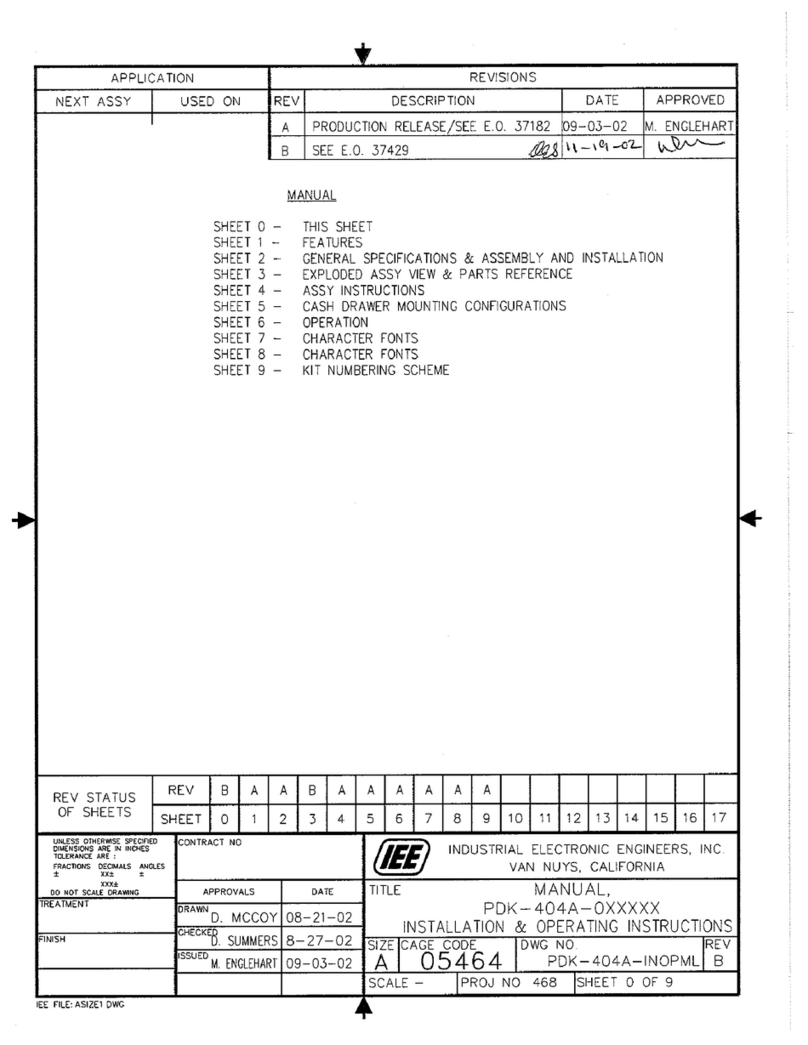
IEE
IEE PDK 404A-0WG13L User manual
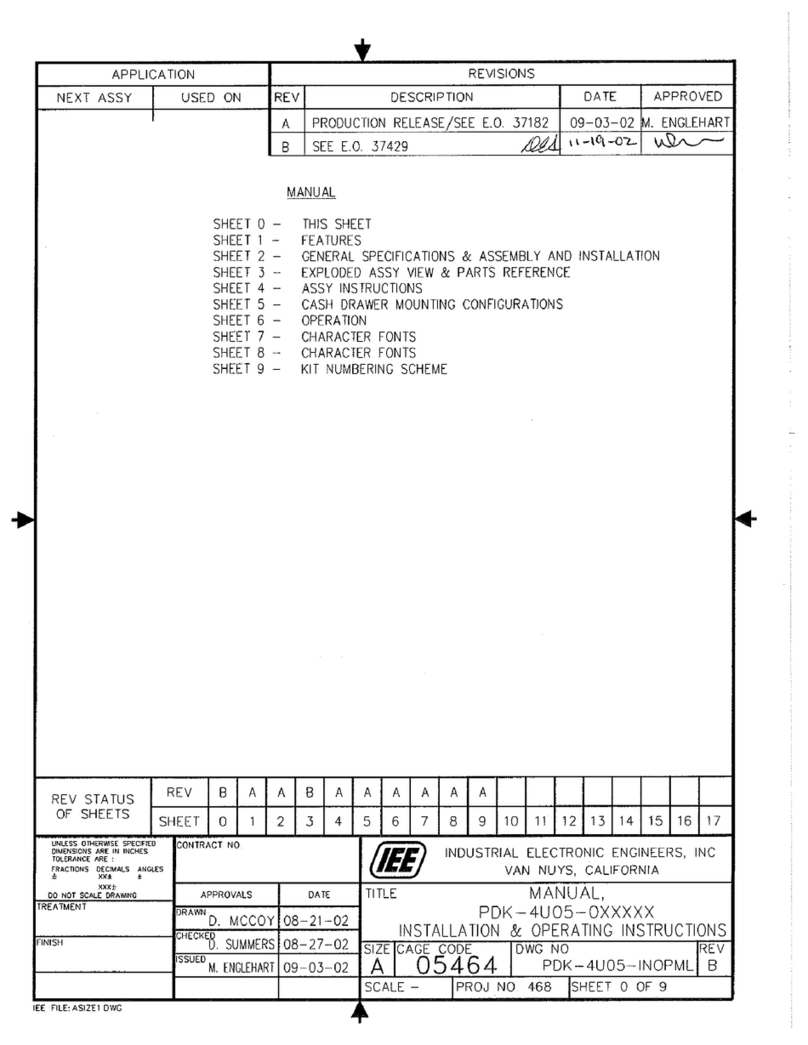
IEE
IEE PDK 4U05-0WG13L User manual
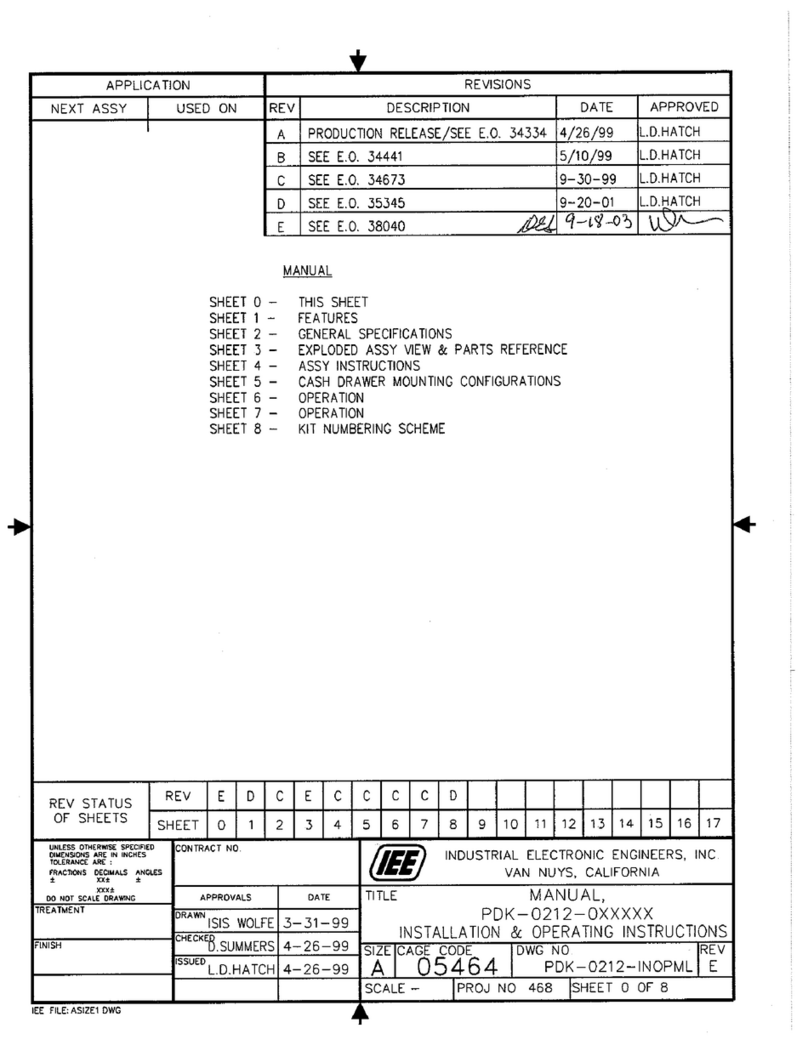
IEE
IEE PDK 0212-OWG13L User manual
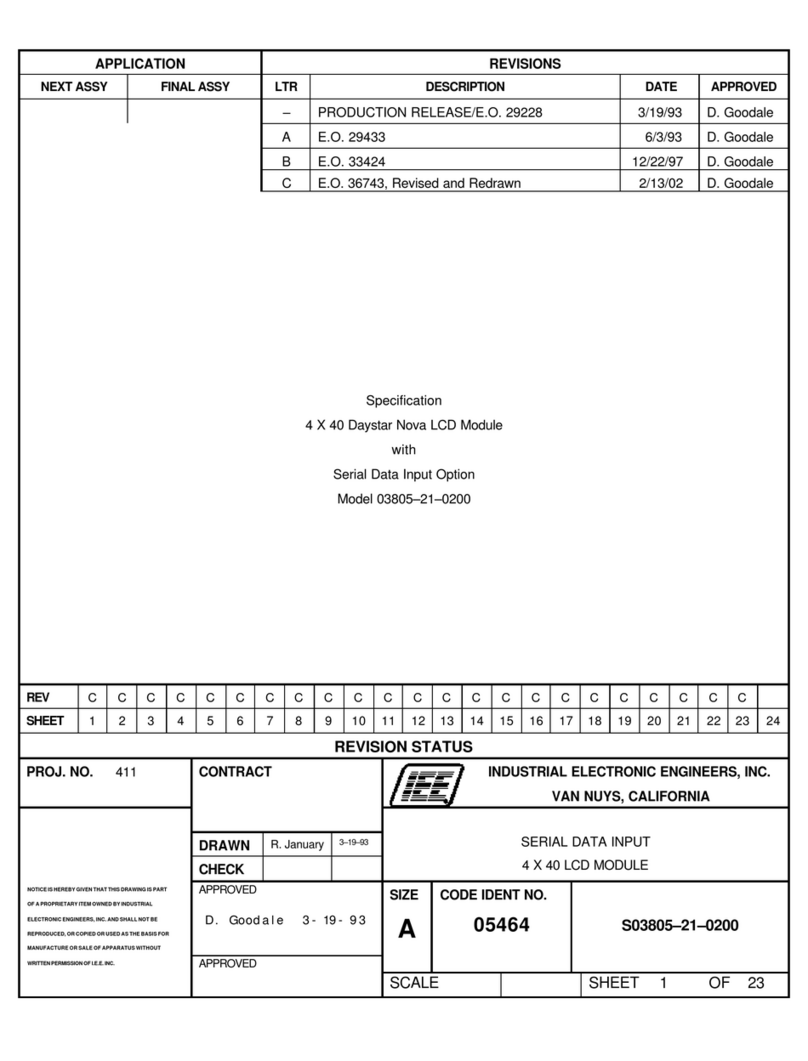
IEE
IEE 03805-21-0200 User manual
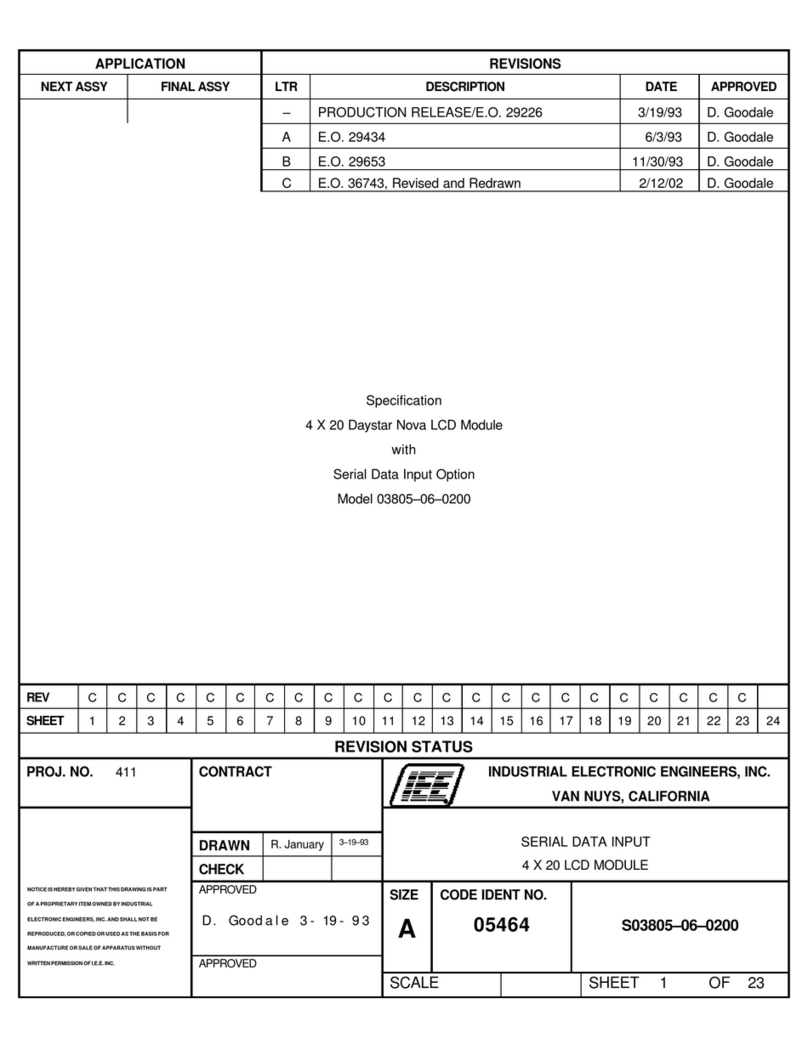
IEE
IEE 03805-06-0200 User manual
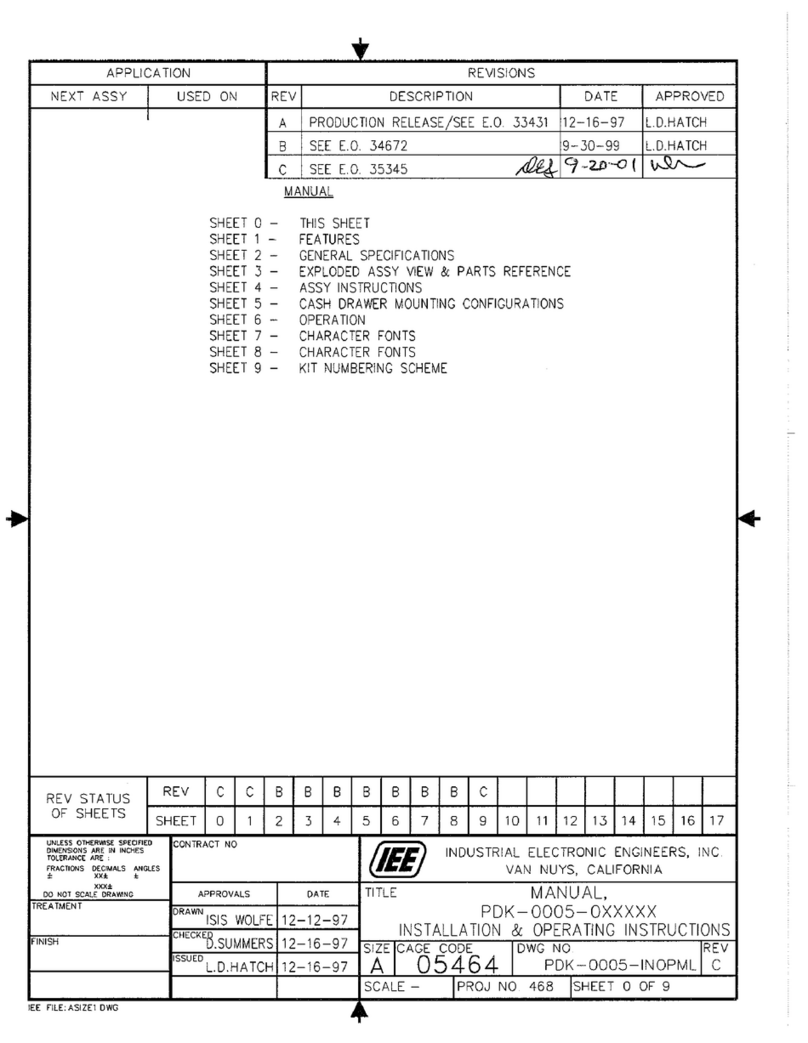
IEE
IEE PDK 005-OWG13L User manual
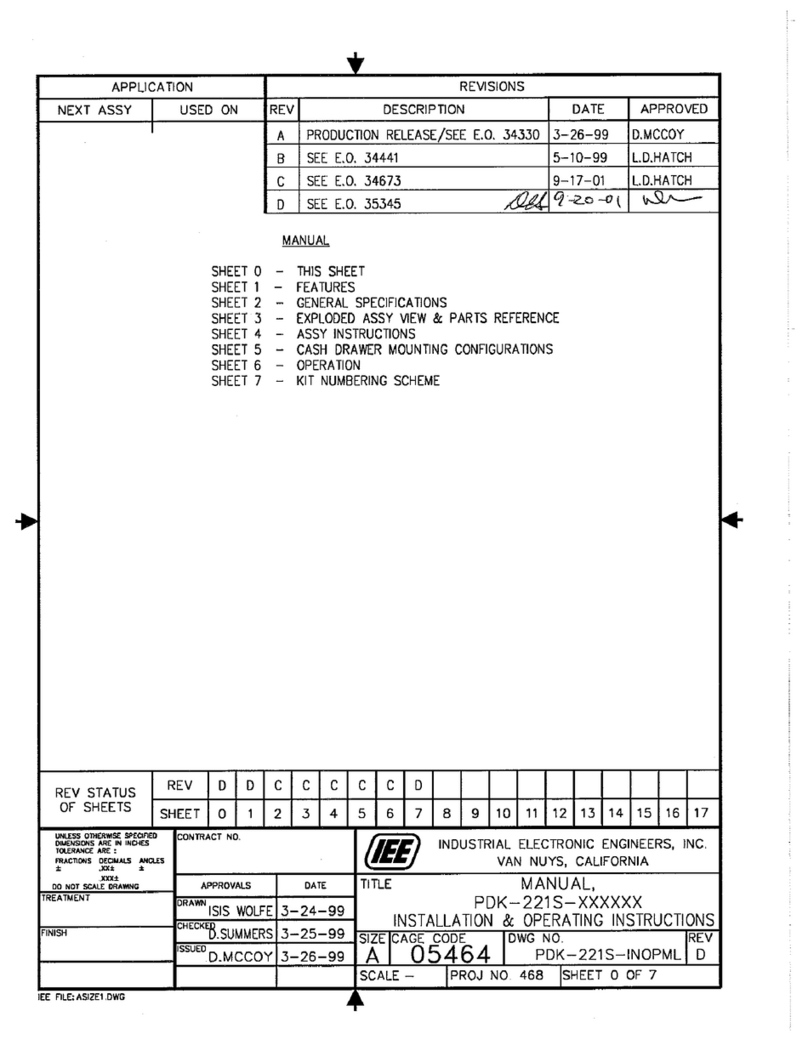
IEE
IEE PDK 221S-CWG13L User manual
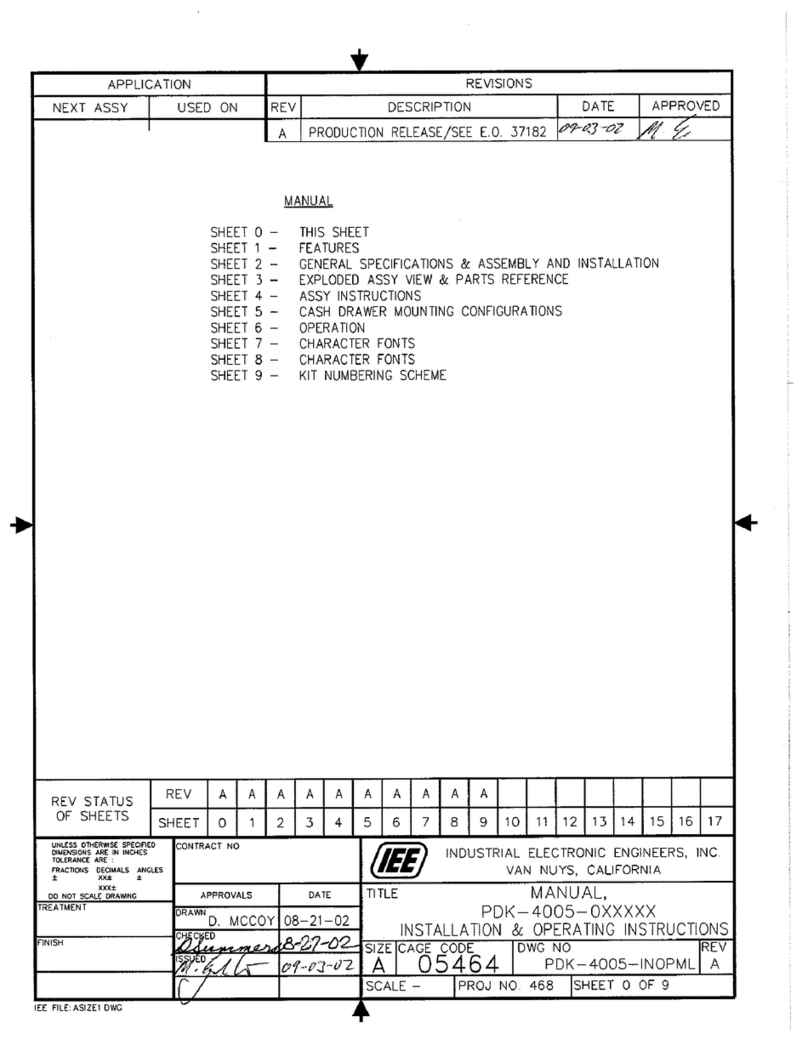
IEE
IEE PDK 4005-0WG13L User manual

IEE
IEE PDK 220S-CWG13L User manual
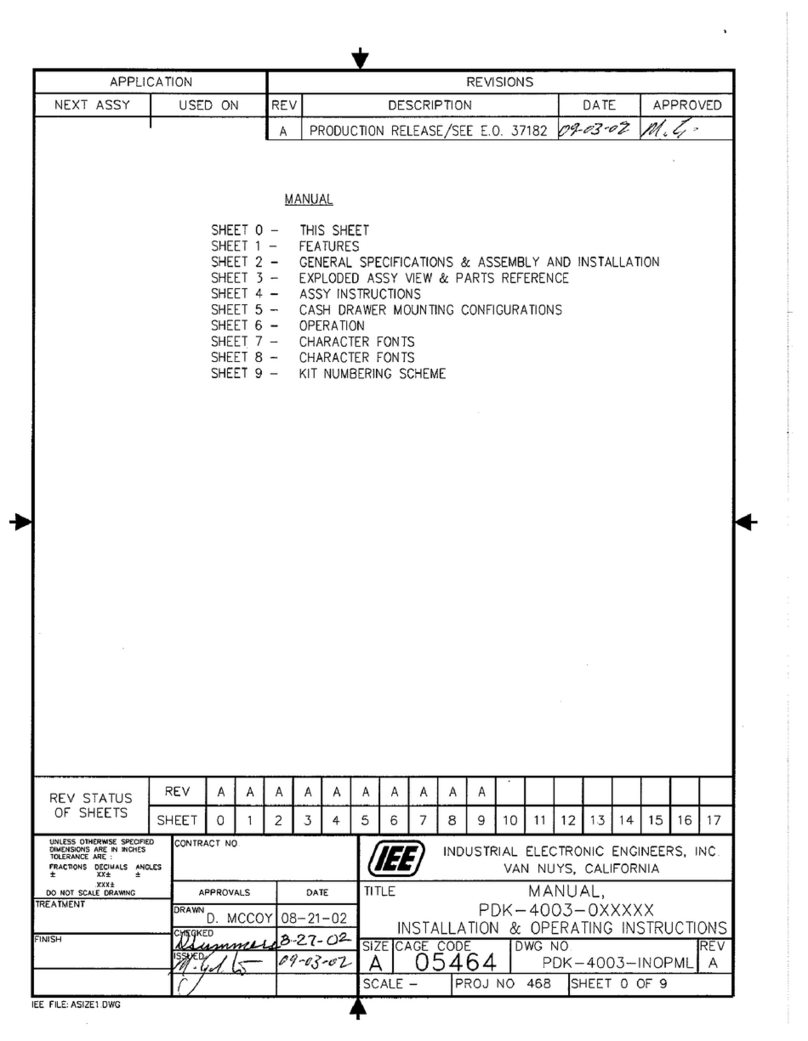
IEE
IEE PDK 4003-0WG13L User manual
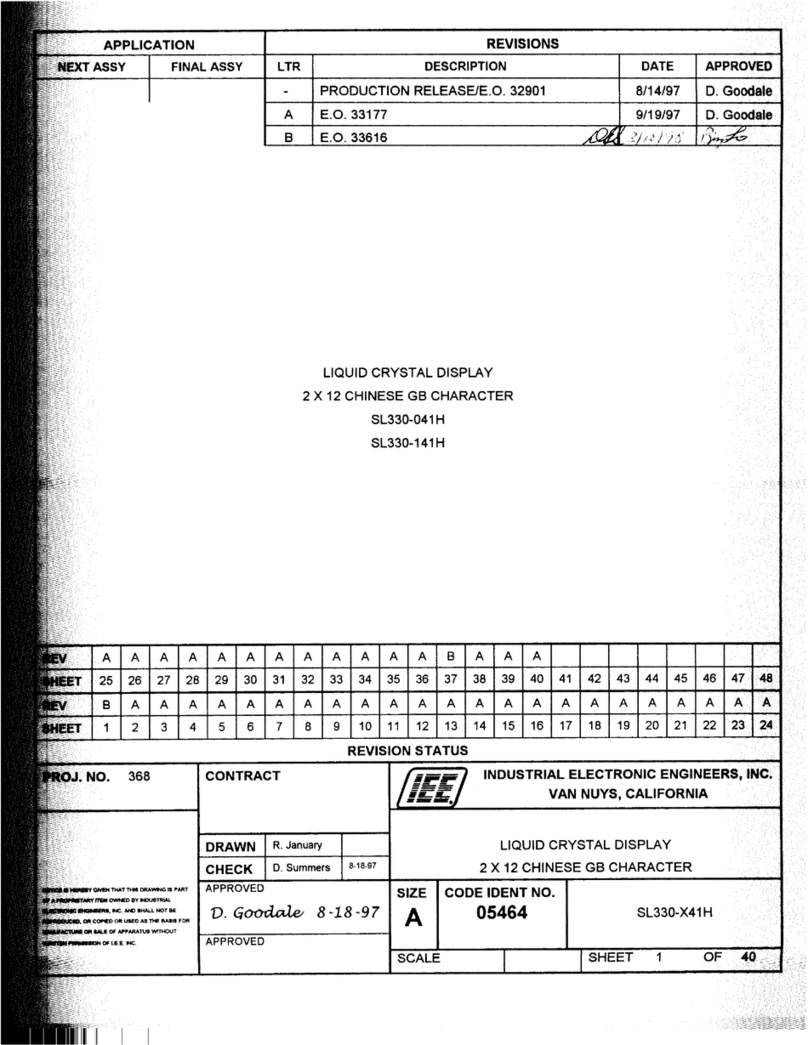
IEE
IEE SL330-X41H User manual
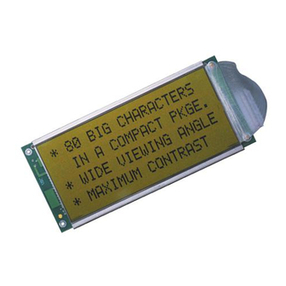
IEE
IEE 03858-06-0105 User manual
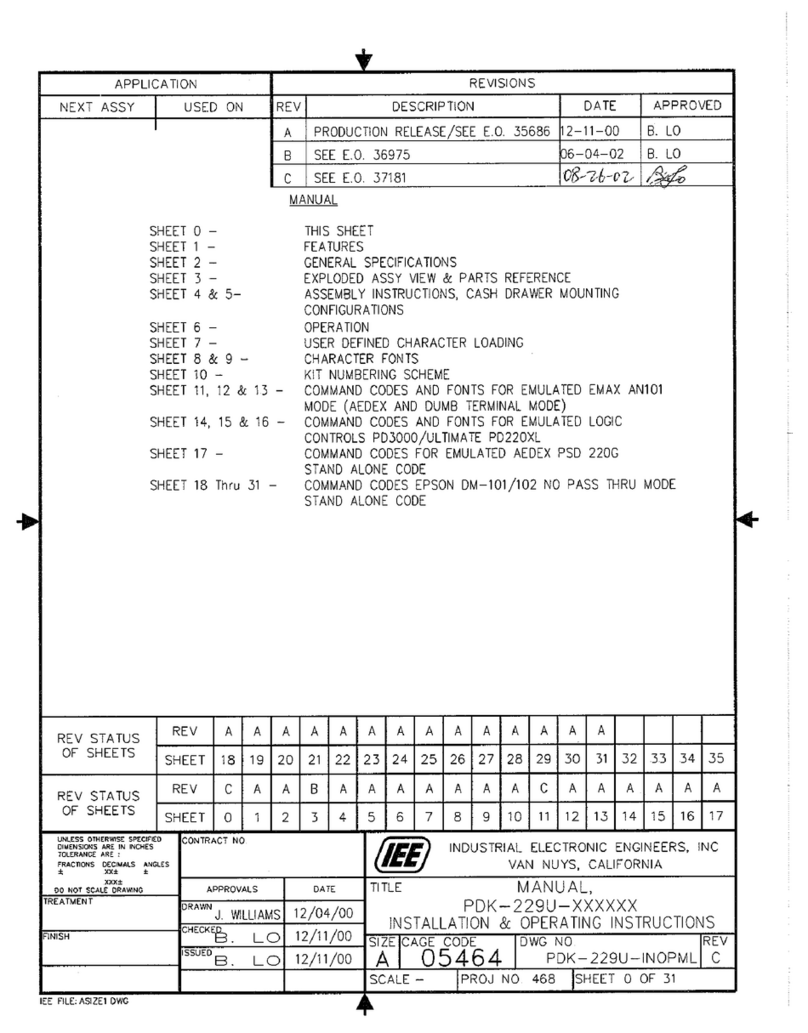
IEE
IEE PDK 229U-CWG13L User manual
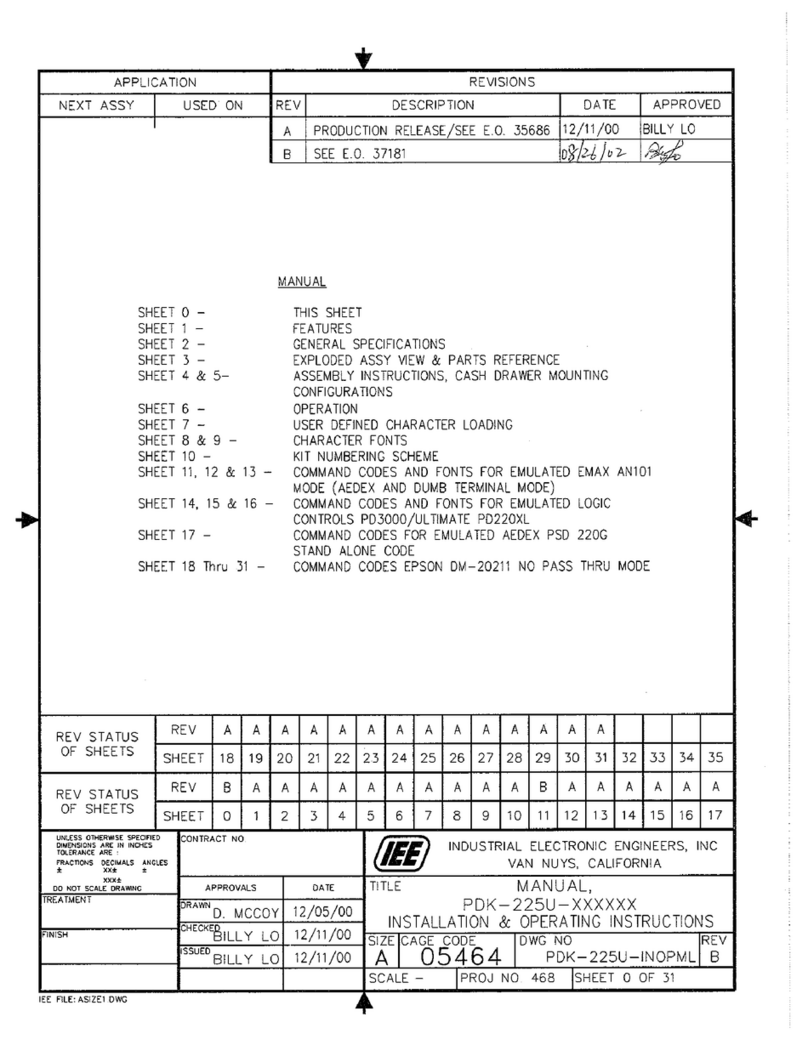
IEE
IEE PDK 225U-0WG13L User manual
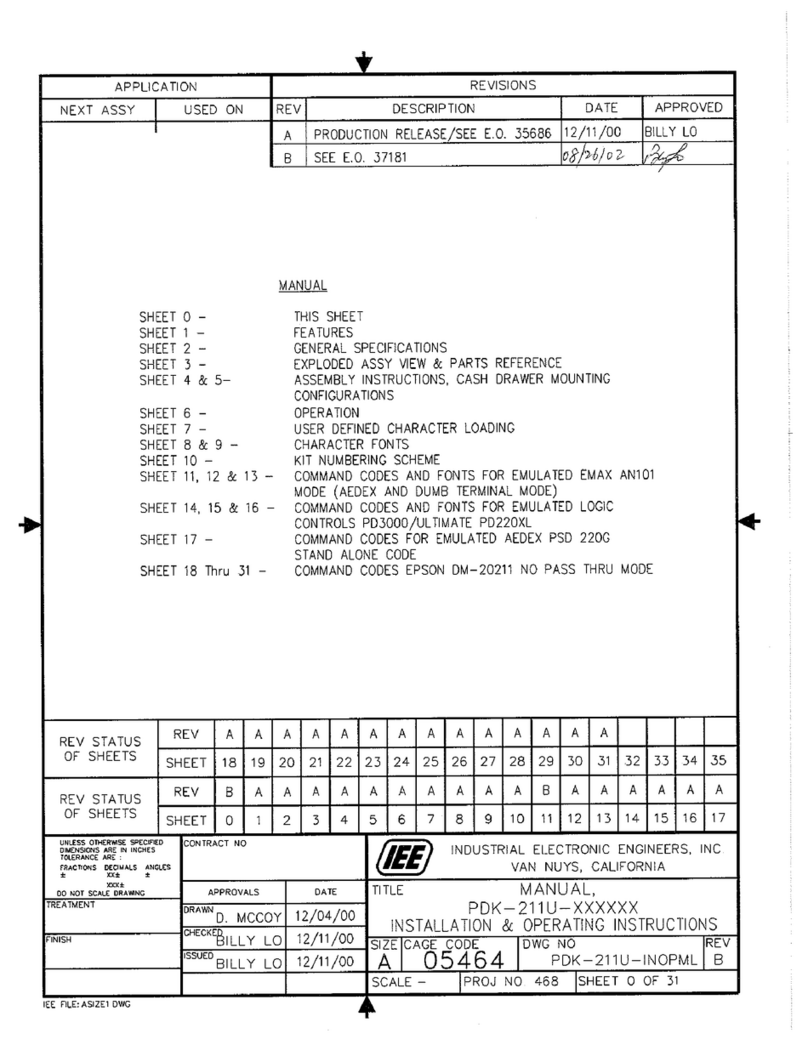
IEE
IEE PDK 211U-0WB000 User manual
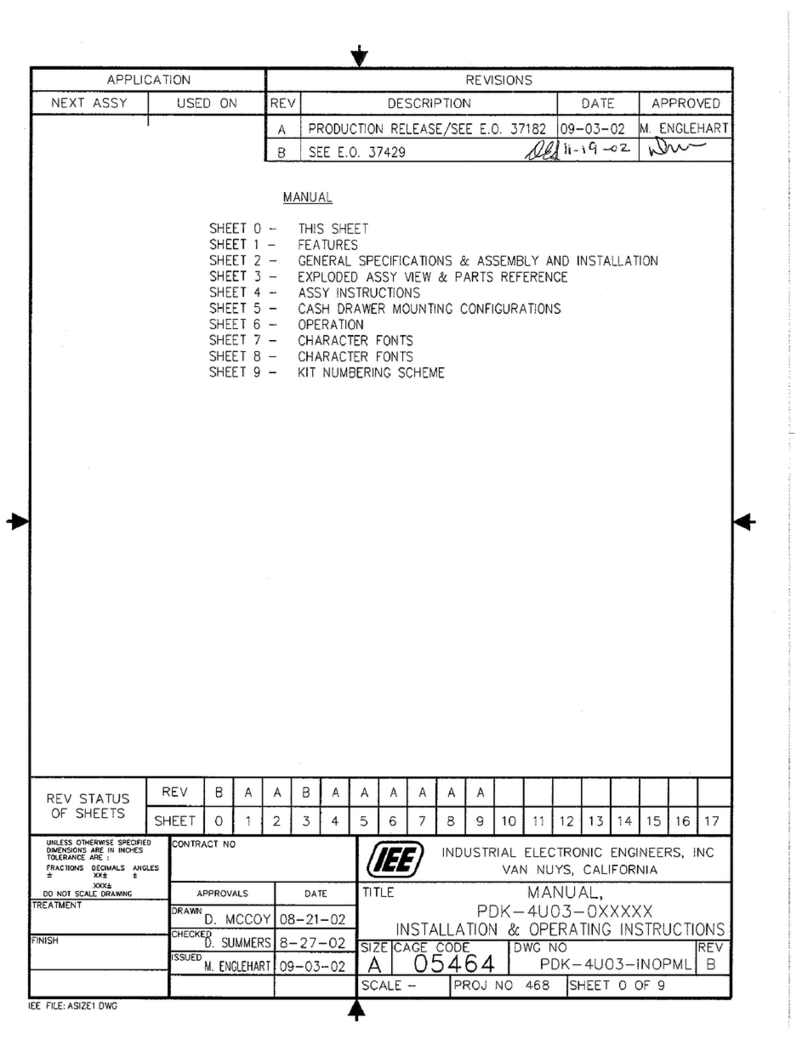
IEE
IEE PDK 4U03-0BG13L User manual
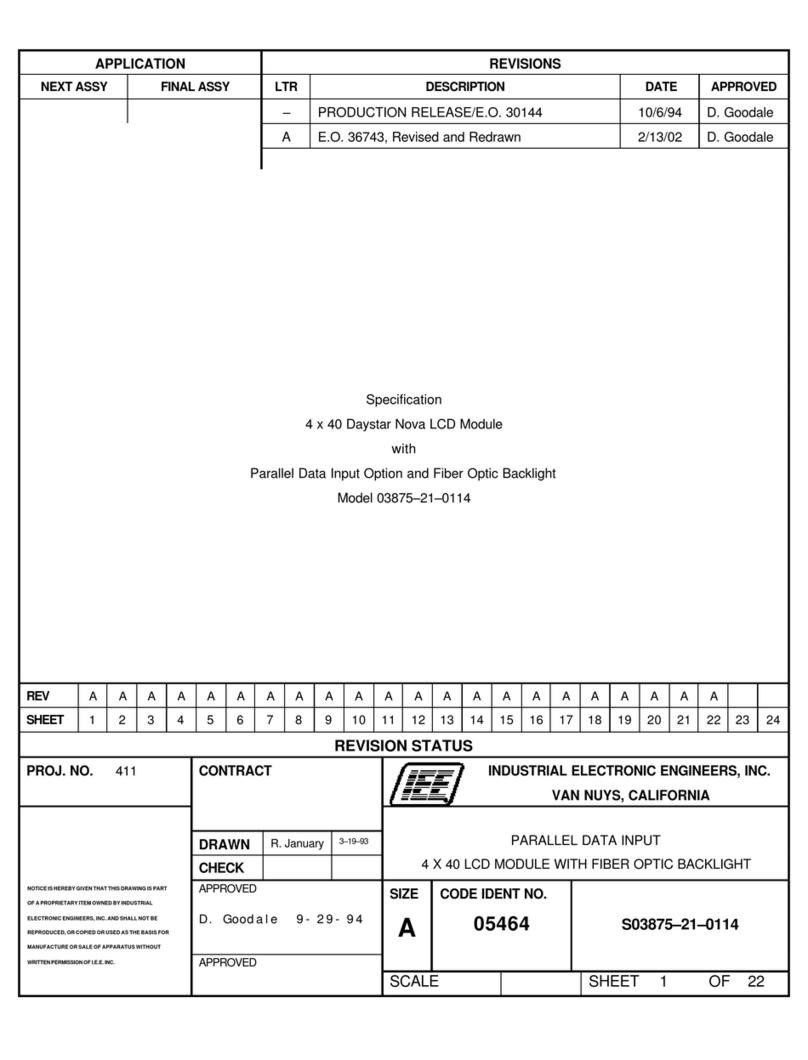
IEE
IEE 03875-21-0114 User manual
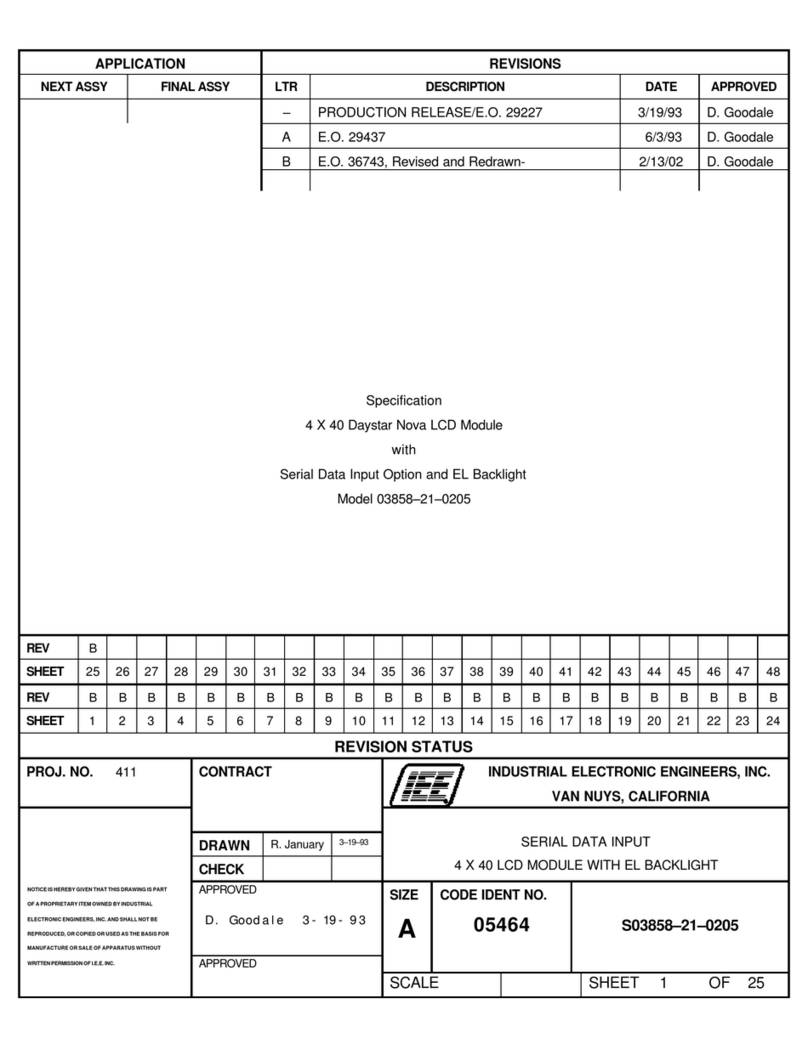
IEE
IEE 03858-21-0205 User manual
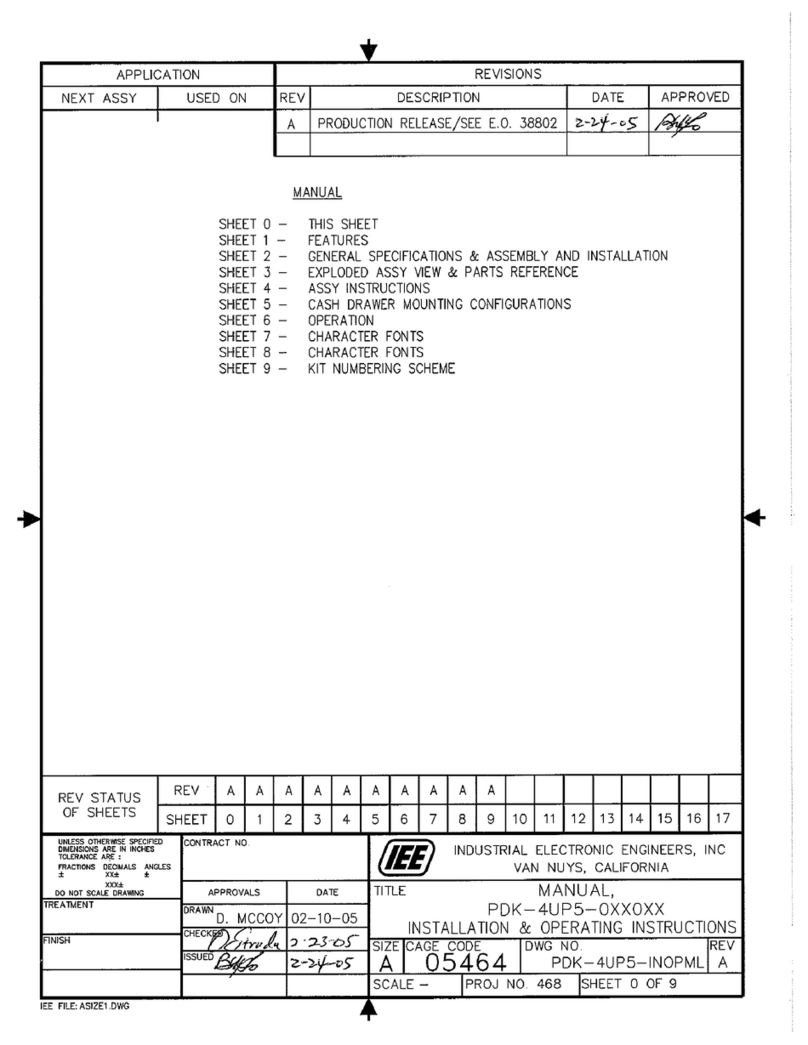
IEE
IEE PDK-4UP5 Series User manual
